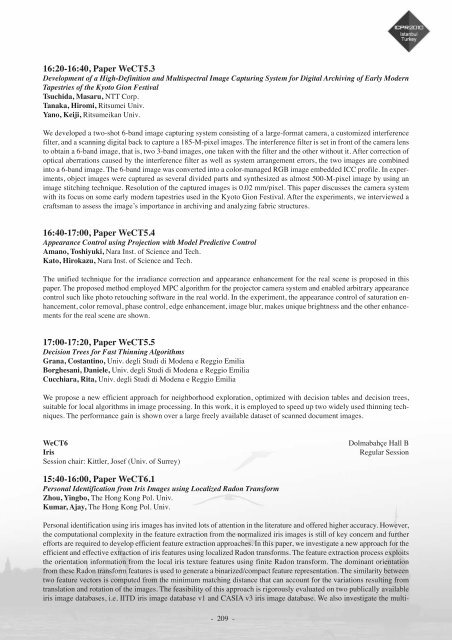Abstract book (pdf) - ICPR 2010
Abstract book (pdf) - ICPR 2010
Abstract book (pdf) - ICPR 2010
- TAGS
- abstract
- icpr
- icpr2010.org
You also want an ePaper? Increase the reach of your titles
YUMPU automatically turns print PDFs into web optimized ePapers that Google loves.
16:20-16:40, Paper WeCT5.3<br />
Development of a High-Definition and Multispectral Image Capturing System for Digital Archiving of Early Modern<br />
Tapestries of the Kyoto Gion Festival<br />
Tsuchida, Masaru, NTT Corp.<br />
Tanaka, Hiromi, Ritsumei Univ.<br />
Yano, Keiji, Ritsumeikan Univ.<br />
We developed a two-shot 6-band image capturing system consisting of a large-format camera, a customized interference<br />
filter, and a scanning digital back to capture a 185-M-pixel images. The interference filter is set in front of the camera lens<br />
to obtain a 6-band image, that is, two 3-band images, one taken with the filter and the other without it. After correction of<br />
optical aberrations caused by the interference filter as well as system arrangement errors, the two images are combined<br />
into a 6-band image. The 6-band image was converted into a color-managed RGB image embedded ICC profile. In experiments,<br />
object images were captured as several divided parts and synthesized as almost 500-M-pixel image by using an<br />
image stitching technique. Resolution of the captured images is 0.02 mm/pixel. This paper discusses the camera system<br />
with its focus on some early modern tapestries used in the Kyoto Gion Festival. After the experiments, we interviewed a<br />
craftsman to assess the image’s importance in archiving and analyzing fabric structures.<br />
16:40-17:00, Paper WeCT5.4<br />
Appearance Control using Projection with Model Predictive Control<br />
Amano, Toshiyuki, Nara Inst. of Science and Tech.<br />
Kato, Hirokazu, Nara Inst. of Science and Tech.<br />
The unified technique for the irradiance correction and appearance enhancement for the real scene is proposed in this<br />
paper. The proposed method employed MPC algorithm for the projector camera system and enabled arbitrary appearance<br />
control such like photo retouching software in the real world. In the experiment, the appearance control of saturation enhancement,<br />
color removal, phase control, edge enhancement, image blur, makes unique brightness and the other enhancements<br />
for the real scene are shown.<br />
17:00-17:20, Paper WeCT5.5<br />
Decision Trees for Fast Thinning Algorithms<br />
Grana, Costantino, Univ. degli Studi di Modena e Reggio Emilia<br />
Borghesani, Daniele, Univ. degli Studi di Modena e Reggio Emilia<br />
Cucchiara, Rita, Univ. degli Studi di Modena e Reggio Emilia<br />
We propose a new efficient approach for neighborhood exploration, optimized with decision tables and decision trees,<br />
suitable for local algorithms in image processing. In this work, it is employed to speed up two widely used thinning techniques.<br />
The performance gain is shown over a large freely available dataset of scanned document images.<br />
WeCT6 Dolmabahçe Hall B<br />
Iris Regular Session<br />
Session chair: Kittler, Josef (Univ. of Surrey)<br />
15:40-16:00, Paper WeCT6.1<br />
Personal Identification from Iris Images using Localized Radon Transform<br />
Zhou, Yingbo, The Hong Kong Pol. Univ.<br />
Kumar, Ajay, The Hong Kong Pol. Univ.<br />
Personal identification using iris images has invited lots of attention in the literature and offered higher accuracy. However,<br />
the computational complexity in the feature extraction from the normalized iris images is still of key concern and further<br />
efforts are required to develop efficient feature extraction approaches. In this paper, we investigate a new approach for the<br />
efficient and effective extraction of iris features using localized Radon transforms. The feature extraction process exploits<br />
the orientation information from the local iris texture features using finite Radon transform. The dominant orientation<br />
from these Radon transform features is used to generate a binarized/compact feature representation. The similarity between<br />
two feature vectors is computed from the minimum matching distance that can account for the variations resulting from<br />
translation and rotation of the images. The feasibility of this approach is rigorously evaluated on two publically available<br />
iris image databases, i.e. IITD iris image database v1 and CASIA v3 iris image database. We also investigate the multi-<br />
- 209 -



